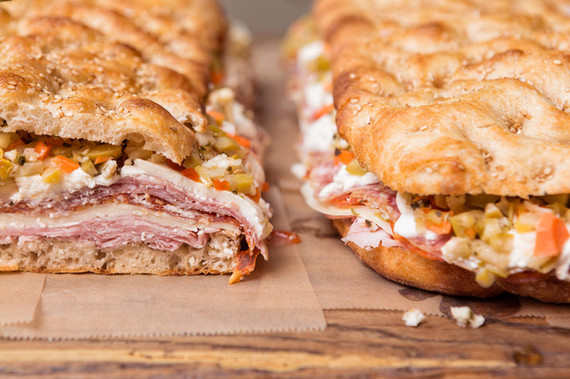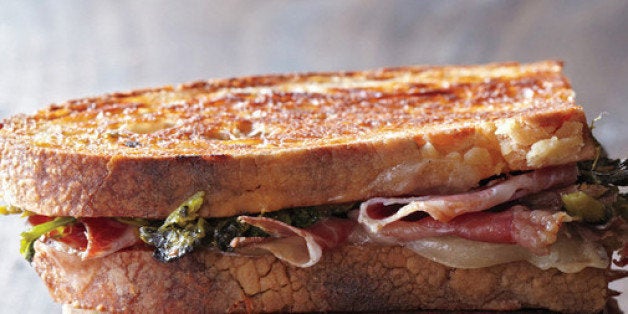By Paula Forbes, Epicurious
How to build a sandwich better.
A really good sandwich is greater than the sum of its parts. Somehow, it's possible to take the exact same ingredients used in an okay sandwich--meat, cheese, vegetables, condiments, bread--and rearrange them into something that's transcendent. But it's not just some kind of sandwich mysticism that separates the great sandwiches from the mediocre.
You can avoid stumbling into bad sandwich territory by strategically layering, cutting, and toasting. The facts: a properly-layered sandwich holds together better, prevents the bread from getting soggy, and achieves optimal texture. And it's as simple as considering which ingredients go where. Check it out:
BALANCE YOUR FILLINGS
Make sure you have a range of textures (silky, crunchy, dense, creamy) and flavors (fatty, fresh, spicy, tart). Balance is key: you don't want to add too many condiments and have them fall off in giant globs, for example.
SLICE THE FILLINGS DOWN TO SIZE
Have you ever bitten into a sandwich only to have all of the fillings slide out? To avoid this, make sure all fillings are either easy to bite through--thinly-sliced meats, cheeses, and vegetables work better than thick ones--or cut into bite-sized pieces.
PAIR OFF YOUR FLAVORS
Next, pair off your sandwich fillings into tasty combos. Mustard and cheese taste great together. So do mayonnaise and tomatoes. So why would you put them on the opposite ends of your sandwich? Other sandwich layer pairings to consider: Meat and pickled vegetables. Lettuce and vinaigrette. Any fresh vegetable and salt, pepper, or other seasonings.
STRATEGIZE LAYERING
Now that you've got your sandwich components paired off, it's time to layer them together into an optimized whole. Denser textures (meat and cheese) work better at the bottom of the sandwich, while vegetables and crunchy elements work better towards the top. You may also layer lettuce throughout to create extra friction, which will prevent dreaded sandwich filling slippage.
Condiments work best spread directly onto the bread, but play around. Rules are made to be broken: maybe you want hot sauce drizzled over a specific vegetable, or you want mustard spread directly on top of meat.

PHOTO: CHELSEA KYLE
CONSIDER TIMING
How soon will you eat your sandwich after it's made? If it's going to be awhile--say you're making a sandwich in the morning to eat at lunch--consider spreading a thin layer of butter on the bread. This will prevent the bread from getting soggy.
Alternately, try using a super crusty bread and letting it soak up liquid on purpose, muffaletta-style. Pile these sandwiches high with meat and pickled vegetables, wrap them tightly in plastic wrap, and wait for magic to happen by lunch time.
TOAST LIGHTLY
Toasting can add a crunch element and can revive stale bread. It can also render an otherwise great sandwich into a harsh, mouth-punishing nightmare. Light toasting is best; take care to make sure the bread doesn't dry out entirely and still has some give in the middle of the slice.
GO DIAGONAL!
Really sloppy sandwiches require a (boring) straight-across cut (a rectangular shape is sturdier, with less thin corners for fillings to slip out of). But most of the time, a diagonal cut is ideal, giving you the longest cross-section possible--and a retro lunchbox look.
Our 2024 Coverage Needs You
It's Another Trump-Biden Showdown — And We Need Your Help
The Future Of Democracy Is At Stake
Our 2024 Coverage Needs You
Your Loyalty Means The World To Us
As Americans head to the polls in 2024, the very future of our country is at stake. At HuffPost, we believe that a free press is critical to creating well-informed voters. That's why our journalism is free for everyone, even though other newsrooms retreat behind expensive paywalls.
Our journalists will continue to cover the twists and turns during this historic presidential election. With your help, we'll bring you hard-hitting investigations, well-researched analysis and timely takes you can't find elsewhere. Reporting in this current political climate is a responsibility we do not take lightly, and we thank you for your support.
Contribute as little as $2 to keep our news free for all.
Can't afford to donate? Support HuffPost by creating a free account and log in while you read.
The 2024 election is heating up, and women's rights, health care, voting rights, and the very future of democracy are all at stake. Donald Trump will face Joe Biden in the most consequential vote of our time. And HuffPost will be there, covering every twist and turn. America's future hangs in the balance. Would you consider contributing to support our journalism and keep it free for all during this critical season?
HuffPost believes news should be accessible to everyone, regardless of their ability to pay for it. We rely on readers like you to help fund our work. Any contribution you can make — even as little as $2 — goes directly toward supporting the impactful journalism that we will continue to produce this year. Thank you for being part of our story.
Can't afford to donate? Support HuffPost by creating a free account and log in while you read.
It's official: Donald Trump will face Joe Biden this fall in the presidential election. As we face the most consequential presidential election of our time, HuffPost is committed to bringing you up-to-date, accurate news about the 2024 race. While other outlets have retreated behind paywalls, you can trust our news will stay free.
But we can't do it without your help. Reader funding is one of the key ways we support our newsroom. Would you consider making a donation to help fund our news during this critical time? Your contributions are vital to supporting a free press.
Contribute as little as $2 to keep our journalism free and accessible to all.
Can't afford to donate? Support HuffPost by creating a free account and log in while you read.
As Americans head to the polls in 2024, the very future of our country is at stake. At HuffPost, we believe that a free press is critical to creating well-informed voters. That's why our journalism is free for everyone, even though other newsrooms retreat behind expensive paywalls.
Our journalists will continue to cover the twists and turns during this historic presidential election. With your help, we'll bring you hard-hitting investigations, well-researched analysis and timely takes you can't find elsewhere. Reporting in this current political climate is a responsibility we do not take lightly, and we thank you for your support.
Contribute as little as $2 to keep our news free for all.
Can't afford to donate? Support HuffPost by creating a free account and log in while you read.
Dear HuffPost Reader
Thank you for your past contribution to HuffPost. We are sincerely grateful for readers like you who help us ensure that we can keep our journalism free for everyone.
The stakes are high this year, and our 2024 coverage could use continued support. Would you consider becoming a regular HuffPost contributor?
Dear HuffPost Reader
Thank you for your past contribution to HuffPost. We are sincerely grateful for readers like you who help us ensure that we can keep our journalism free for everyone.
The stakes are high this year, and our 2024 coverage could use continued support. If circumstances have changed since you last contributed, we hope you'll consider contributing to HuffPost once more.
Already contributed? Log in to hide these messages.

